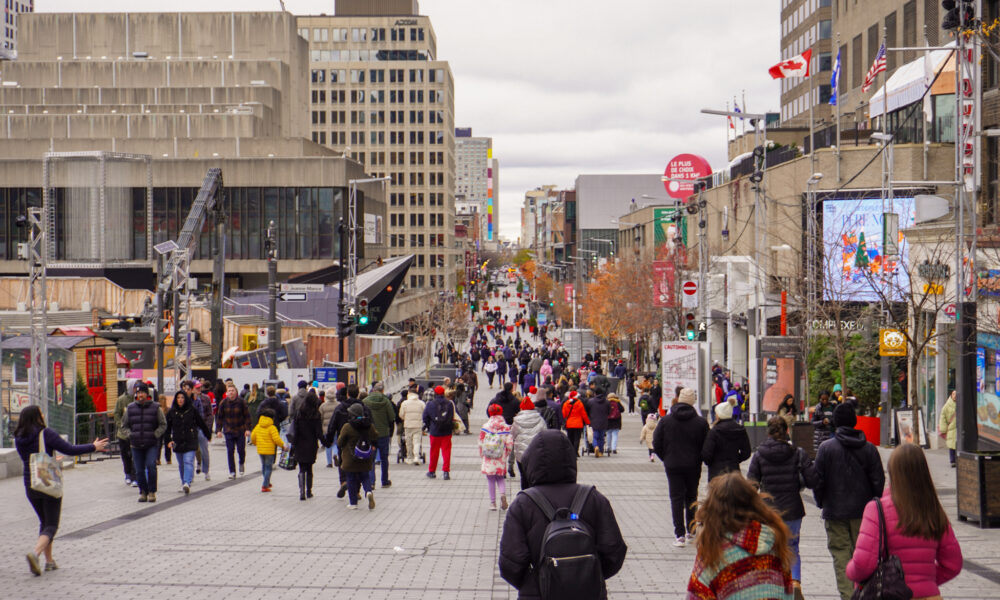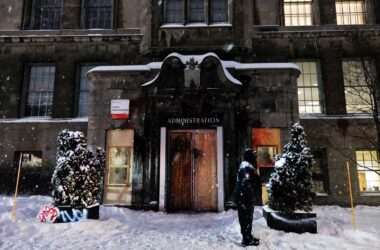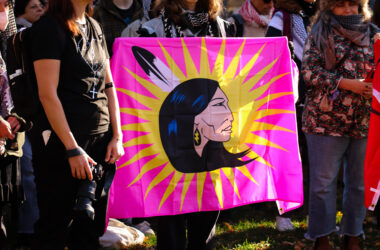A last-minute battery replacement for your beloved laptop that’s well past its prime. A new top for a first date when you have nothing to wear. A warm pair of gloves because, yes, Montreal really is as cold as your mom warned it would be. A trip to the Eaton Centre’s Time Out Market when dining hall food just isn’t cutting it. Rue Sainte-Catherine has it all.
McGill students and Montrealers alike faithfully flock to Sainte-Catherine’s urban thoroughfare in astounding numbers: Half a million pedestrians are estimated to walk the street every day. Its unique popularity lies in the fact that—beyond the usual shopping outlets, cultural centres, and public squares—Sainte-Catherine takes on a unique form during the summer, one that it should arguably occupy all year round.
Transforming into a pedestrian-only street between the months of May and October, Rue Sainte-Catherine is home to a high volume of festivals and cultural activities, including the Montreal Pride Parade, the annual Rue Sainte-Catherine Sidewalk Sale, and the Montreal International Jazz Festival. On a more basic level, the pedestrianized street is also opened to street-vending by local retailers, used by businesses to expand outdoor seating arrangements, and even made available for temporary art installations.
Rue Sainte-Catherine is not alone in this practice of seasonal pedestrianization. In fact, Montreal has been strategically pedestrianizing its streets for years post-pandemic, with many significant thoroughfares like Mont-Royal Avenue ceasing to admit car traffic during the summer and fall months. Clearly, the city’s Urban Planning and Development department is gradually adopting a broader practice of pro-pedestrian modifications to the city’s landscape.
However, the opportunity for increased community activity and walkability is not convincing enough for every Montrealer to embrace year-long car-free legislation. Business owners and residents alike have expressed concerns about the full-time pedestrianization project. They fear that economic activity will be slowed and general aesthetics hindered without deliveries and trash collection services being taken on by vehicles. Montreal residents have also theorized that converting Rue Sainte-Catherine to pedestrian-only will force congestion out to neighbouring streets.
These concerns—while completely understandable—overlook the proven benefits of the pedestrianization policy. Such a car-free policy would not occur in isolation; pedestrianization legislation is coupled with improvements in public transportation and developments in pedestrian and bike infrastructure. The vacuum created by a lack of cars on Rue Sainte-Catherine would thus be quickly filled, presenting a transformative opportunity for the city to turn what was once a street into a vibrant urban zone.
With the street no longer being plagued by vehicular air pollution, the sound of irritable honks from drivers, and a general inefficiency in space usage, Sainte-Catherine could become home to a green community space. Such a shift in the street’s presentation bears additional relevance when considering that, once a street becomes increasingly designed around the well-being of its pedestrians, foot traffic has been shown to increase.
When pedestrian presence increases, it’s not just the vibe of the city that’s bolstered; local economies are too. For example, when Toronto’s Public Works and Infrastructure Committee implemented a 2016 resolution to replace on-street parking with bike lanes on the major thoroughfare Bloor Street, both monthly spending by customers and the number of customers themselves increased. The alleged decline in consumer activity that has been causing anxiety among Sainte-Catherine merchants is, truly, a myth, and the data shows this. Business—particularly restaurant—owners tend to overrepresent the significance of cars to economic activity due to the dominance of services like Uber Eats and GrubHub. In reality, the real spenders are the pedestrians walking by and peering into storefronts.
The pedestrianization of Rue Sainte-Catherine is a crucial step towards promoting Montreal’s cultural life, improving the city’s environmental health and boosting small business finances. While disruption to the car-oriented status quo may be intimidating for long-time residents, this change is necessary to set an urban landscape standard for generations to come.
Besides, Rue Sainte-Catherine is perpetually under construction anyway. Montrealers might be more used to the idea of a car-free future than they realize.









